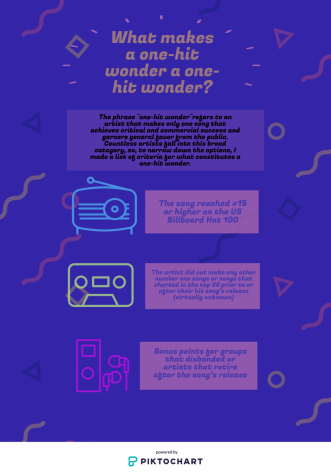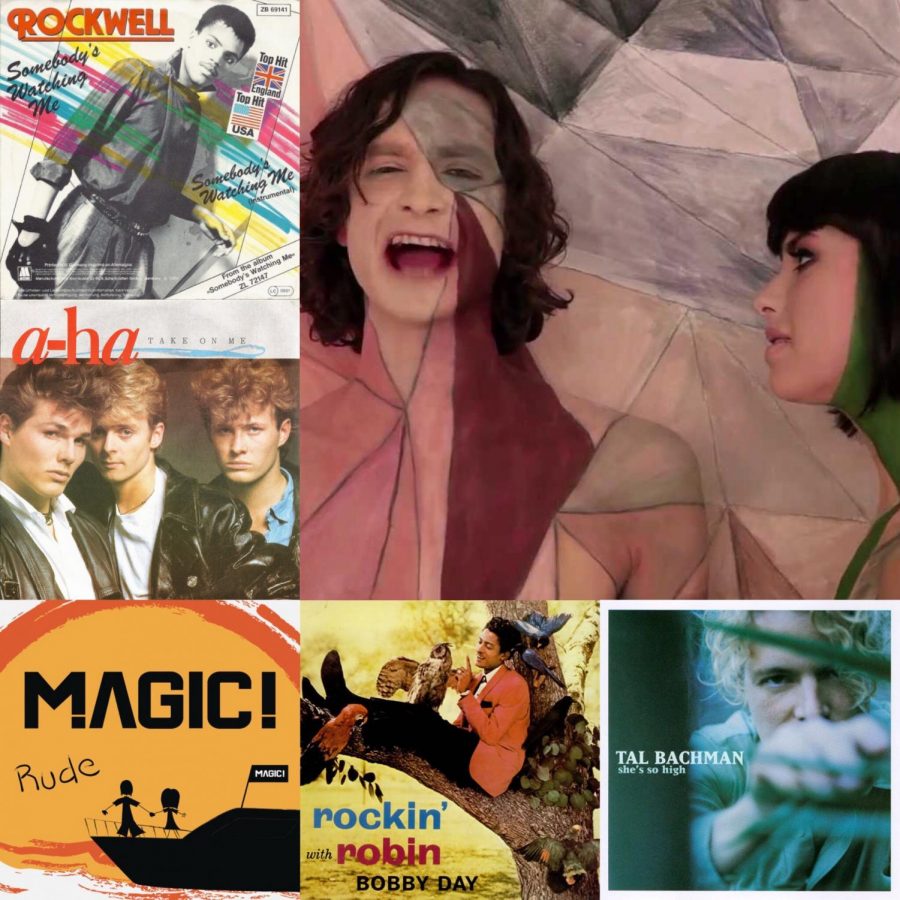One-Hit wonders through the years
Music critics debate the exact meaning of the phrase “one-hit wonder” and its origins. Apparently, Winnipeg Free Press first used the term in the late 1970s when describing how the pop group Abba avoided this label. Data journalist Dan Kopf believes that one-hit wonders could become extinct because of the ever-changing music industry. Others argue that social media kills one-hit wonders because artists can release music quickly and use their social media presence to build a dedicated fanbase.
March 8, 2019
It happens all the time—we hear songs we know all too well by artists we do not know at all. One-hit wonders become overwhelmingly popular—seemingly out of the blue—but then, when the public finds another song to play on the radio ad nauseum, the artist fades into obscurity, overshadowed by their own creation. Despite their odd nature, one-hit wonders show what sounds and music genres America enjoys at any given time. I compiled a list of one-hit wonders from each decade, in order to reveal its distinct, most popular sounds.

1950s
Song: “Rockin’ Robin”
Artist: Bobby Day
Year: 1958
Chart Performance: “Rockin’ Robin” peaked at #2 on the Billboard Hot 100 and stayed on the charts for 11 weeks.
How it embodies the decade: This classic Rock ‘n’ Roll song’s simple rhythm and timeless lyrics allowed it to remain popular 60 years after its initial release. The song’s homophonic texture highlights the artist’s vocal talents and makes it easy to listen to. Rock ‘n’ Roll music played an integral role in the teenage rebellion of the 1950s.
Aftermath: Day shifted from singing to songwriting in 1960.
1960s
Song: “Wipeout”
Artist: The Surfaris
Year: 1963
Chart Performance: “Wipeout” peaked at #2 on the Billboard Hot 100 and remained there for four months.
How it embodies the decade: The song exemplifies the surf rock subgenre that emerged from Southern California during the mid-1960s. Groups like The Ventures, The Champs, and The Beach Boys enjoyed mainstream success within this genre. Other popular rock subgenres during this era included psychedelic rock, folk rock, and hard rock.
Aftermath: The group failed to make an impact on the charts following the hit song’s release.
1970s
Song: “Ring My Bell”
Artist: Anita Ward
Year: 1979
Chart Performance: This track reached #1 on the Billboard Hot 100 and stayed on the charts for 8 weeks total.
How it embodies the decade: This song ended a decade where disco music dominated the charts. Ward actually did not like the song when the owner of her record label, Frederick Knight, first presented her with it, but the popularity of disco music prompted her to record the song, and it became Ward’s only hit. “Ring My Bell” utilizes chimes and an early version of synthesized drums. Though disco’s popularity quickly ceased at the beginning of the 1980s, the ideas of unity it left behind inspired a carefree, innovative generation.
Aftermath: After the release of “Ring My Bell,” Ward’s only other charting single, “Don’t Drop My Love”, peaked at #87 in the US.
1980s
Song: “Somebody’s Watching Me”
Artist: Rockwell
Year: 1984
Chart Performance: This song remained on the Billboard Hot 100 for nine weeks and peaked at #2.
How it embodies the decade: The perfect example of a one-hit wonder, “Somebody’s Watching Me” combines the synth-pop sounds with a catchy hook sung by Michael Jackson and an eerie, yet playful tone, to create a single that went on to sell over one million copies. The song incorporates elements from the new wave genre, which relied heavily on synthesizers and electronic instruments.
Aftermath: Rockwell’s next two singles, “Obscene Phone Caller” and “He’s A Cobra” peaked at #35 and #108, respectively, and he subsequently retired from music.
1990s
Song: “She’s So High”
Artist: Tal Bachman
Year: 1999
Chart Performance: “She’s So High” peaked at #14 on the Billboard Hot 100 and reached #1 on the US Adult Top 40.
How it embodies the decade: This pop rock song emulates the guitar-centric style of the alternative rock and happy rock subgenres that became popular during the ’90s. Bands like Nirvana pioneered the grunge movement that began in the middle of the decade. Also, the device (CD players) people used to listen to music changed when CDs became more popular than cassettes and tapes for their improved sound quality.
Aftermath: Bachman released his most recent album, Staring Down the Sun, in 2004; it did not chart in the US.
2000s
Song: “Bad Day”
Artist: Daniel Powter
Year: 2005
Chart Performance: This song reached #1 on the Billboard Hot 100.
How it embodies the decade: The first single released from Powter’s sophomore album, “Bad Day” received plenty of airplay in 2006, and it became the #1 song of the year. The RIAA certified it triple-platinum in the U.S., indicating that it sold over three million copies. The mainstream pop song relies heavily on piano, and it differs from the hip-hop and emo genres that emerged during that era.
Aftermath: Powter continued to make music after “Bad Day,” but it failed to reach the charts. He released a new single, “Survivor”, in December 2018.
2010s
Song: “Somebody That I Used To Know”
Artist: Gotye (ft. Kimbra)
Year: 2011
Chart Performance: “Somebody That I Used To Know” peaked at #1 on the Billboard Hot 100, and it stayed there for eight weeks.
Aftermath: While Kimbra released new music as recently as April 2018, Gotye did not produce a follow-up to 2011’s Making Mirrors.







